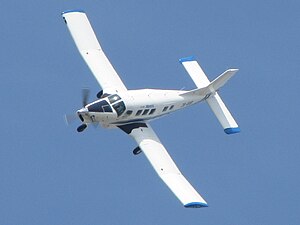PAC P-750 XSTOL
| P-750 XSTOL | |
|---|---|
 |
|
| Role | Utility aircraft |
| National origin | New Zealand |
| Manufacturer | Pacific Aerospace |
| First flight | 2001 |
| Status | Active in production |
| Produced | 2001-present |
| Unit cost |
$US1.7-2.2 million
|
| Developed from | PAC Cresco |
The PAC P-750 XSTOL, (formerly known as the PAC 750XL) is a utility aircraft of conventional all-metal low-wing monoplane design, with fixed tricycle undercarriage. Combining the engine and wings of the PAC Cresco with a new large fuselage and modified tail, all versions to date have been powered by a 750 hp (560 kW) Pratt & Whitney Canada PT6 turboprop. It is designed and manufactured in Hamilton, New Zealand by Pacific Aerospace Limited.
The design made its maiden flight in 2001. As with the Cresco, horizontal tail surfaces presented difficulties, and these were redesigned before the type entered production. The PAC 750 received full US FAA certification in 2004.
The type was targeted initially to the narrow market of skydiving. In the parachuting role, the high-lift wings from the Cresco and relatively high power-to-weight ratio enable the PAC 750 to take a load of parachutists to 12,000 feet (3,700 m) and return to land in 10 minutes.
A wider market was subsequently sought, and examples have been sold for use in utility roles, including freight, agricultural applications, passenger operations, aerial photography and surveying. Two aircraft have been extensively modified for geo-survey work, being fitted with a magnetic anomaly detector sting tail. Proposed ski and float conversions have yet to fly. The P-750 XSTOL is used in South Africa by NatureLink on United Nations Humanitarian Air Services / World Food Programme contracts. While the manufacturer claims lower single-engine running costs than many other utility types, for example, the twin-engined DHC-6 Twin Otter, the type has less usable volume (large cargo panniers providing a partial solution).
...
Wikipedia
